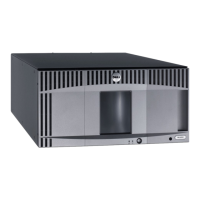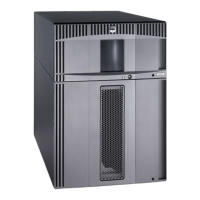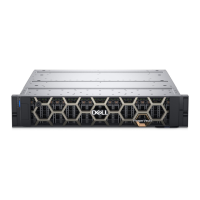Configuring Your Library
file:///T|/htdocs/stor-sys/ML6000/en/html/ch04.htm[9/17/2012 1:49:29 PM]
authentication is enabled:
• Login Account includes the name of a valid account on the SMTP server (for example, "John.User"). The login
account name can contain the following special characters: @ and #.
• Password is the password for the account that you specified in the Login Account text box. The password can
contain the following special characters: @ and #.
• Send a test e-mail to allows you to enter an e-mail address you want to test. Enter the address and click Send
e-mail. Then check the e-mail account to verify that an e-mail message was sent from the library.
After configuring the e-mail account, save the library configuration. For information, see Saving and Restoring the Library
Configuration.
You can configure the library e-mail account from the Web client only, but you can view e-mail account information from the
operator panel.
The paths to open the appropriate screens are as follows:
• From the Web client, select Setup > Notifications > E-mail Configuration.
• From the operator panel, select Setup > Notification > E-Mail Account.
Working With RAS E-mail Notifications
The library can be configured to automatically send e-mail notifications to specified e-mail addresses whenever an issue of a
particular severity level occurs with one of its components. The information in the e-mail notification provides details about
the issue and the library conditions at the time of the error.
Before you can configure e-mail notifications, you must configure the library's e-mail account so that the library can send
notifications to the designated recipients. See
Configuring the Library E-mail Account for information on how to configure the
e-mail account.
See
Creating RAS E-mail Notifications for information on setting up additional e-mail notifications. The library supports a
maximum of 20 e-mail notification recipients.
There are three e-mail notification filter levels:
• Low Filter — Notifies e-mail recipients of all RAS tickets and information notifications.
• Medium Filter — Notifies e-mail recipients of high-severity (Severity 2) and urgent (Severity 1) RAS tickets.
• High Filter — Notifies e-mail recipients of urgent (Severity 1) RAS tickets only.
Administrators can configure the library e-mail account and e-mail notifications. Users can receive e-mail notifications, but
they cannot configure the library e-mail account and/or notifications.
You can configure e-mail notifications from the Web client only, but you can view them from the operator panel.
The paths to open the appropriate screens are as follows:
• From the Web client, select Setup > Notifications > RAS > Receiver Addresses.
• From the operator panel, select Setup > Notification > E-mail Alerts.
Creating RAS E-mail Notifications
Administrators can create e-mail notifications. The library supports a maximum of 20 e-mail notification recipients. Each e-
mail notification recipient must have a unique e-mail address.
To set e-mail notifications, you need to provide the e-mail address and filter level setting for the recipient. For more
information on filter levels, see
Working With RAS E-mail Notifications.
Each e-mail notification includes an optional Comments text box you can use to enter important system configuration details,
such as the network environment or third-party software applications that interface with the library. Such information will
appear in the body of the e-mail and can help technical support personnel to troubleshoot the library.
Note: Do not enter more than one address in the Enter E-mail Address text box. If you need to send e-mail
notifications to multiple addresses, create an e-mail notification for each e mail address.

